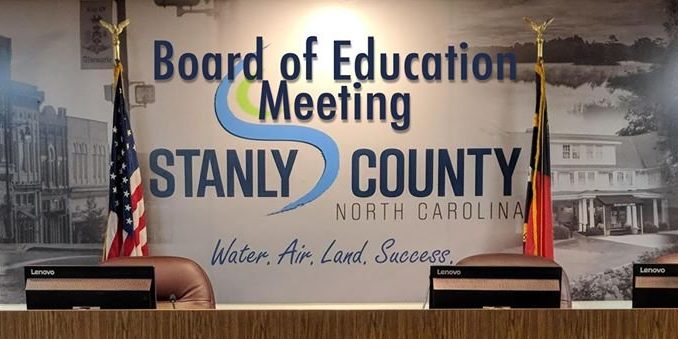
ALBEMARLE – The Stanly County Board of Education met Tuesday, January 3, with multiple recognitions on the agenda.
The board of education recognized several of their teachers that received Bright Ideas grants.
“The Bright Ideas grants are done across North Carolina, and they’re done by the electrical cooperatives,” said Superintendent Jarrod Dennis. “In our county, we have two cooperatives, Pee Dee Electric and Union Power, that service parts of our county, so, therefore, we have two different cooperatives teachers can apply for.”
Four teachers received grant funding for projects.
Tamara Furr, a special education teacher at South Stanly High School, received $2,000, which she used for a laser engraver to help her students receive work hours and develop job, social and life skills.
Shelly Vetter, a physical education teacher at Badin Elementary School, received $1,412 that she used for cardio drumming equipment for students.
Callie Thigpen, a teacher at West Stanly Middle School, received $958 and used it for two chicken coops, an incubator, and feeding and watering equipment for the chickens so students could see the entire life cycle of a chicken.
Mary Barbee, the Digital Learning and Media Innovations Facilitator also at West Stanly Middle School, received $860, which she used for higher quality video equipment for her class. Barbee also ended up receiving the NC Go Outdoors Grant.
“She actually got a call from Senator Carl Ford saying she was awarded the NC Go Outdoors Grant in the amount of $12,412, and this will bring an outdoor classroom with sunshade, picnic tables, an outdoor sink, and furniture to West Stanly Middle School,” Dennis said.
The board was then presented with the findings of their 2021-22 audit.
“We’re pleased to report that our audit report on the financial statements is an unmodified report,” said Andy Deal, partner with Anderson Smith and Wike PLLC, who performed the audit. “You can also call that a clean report. The reason it’s referred to as an unmodified report is that means we didn’t note anything in our audit that would cause us to modify our audit report.”
While the audit didn’t find any issues per se, one area of concern that was brought up was the state of the district’s fund balance.
“As of June 30, 2022, we’re showing just under $775,000 of fund balance,” Deal said. “Being honest, for a district of your size, that’s way too low, in my opinion. I would work to try and grow that fund balance. Your general fund balance is basically your financial backup plan. If you get cuts at the state and federal level, you can’t raise tuition or anything, but you can fall back on your fund balance and your general fund, or you can make cuts. So if you don’t have a fund balance, you’re just left with cuts.”
Deal stated that the district should aim for at least triple what they currently have in fund balance, but he also said how that could be difficult.
“Rural districts struggle to grow fund balance,” Deal said. “There’s not a lot of small, rural districts that have fund balance. To keep a good relationship with the county, they usually have to spend their fund balance, and I’ve seen that in more than one place. To me, the small rural districts that do have a fund balance, most of them, if not all of them, have a small supplemental tax that goes straight to the school districts. It’s really hard to grow it if you don’t have a county that wants it to grow.”
However, Deal also pointed out that the district had over $3.5 million in special revenue fund and over $3 million in capital outlay fund, which could also be used in a pinch.
Finally, the board approved a bid for printing services.
“Obviously, we are approaching the end of our current contract, which was a five-year contract, and given the supply chain issues and stuff, I wanted to get ahead of it,” said Chief Technology Officer Shawn Britt. “We set out to make three goals in doing that. Those goals are stated as identifying potential cost savings, upgrading our current equipment, and having more built-in security.”
“In the end, we decided to go with Toshiba, the current vendor we have. The determining factors in selecting them were that they were our current provider, so we have a positive relationship with them, and overall their pricing was about $6,000 less per month than all the other vendors. The last agreement we had with them, per quarter, was $5.82 per student, which rounded out to about $200,000 per year. This new agreement has it down to $4.96, which would be $170,000 per year. So total savings of $30,000 with upgraded equipment and security features.”
Britt identified a change in teaching methodology as a big reason for the cost decrease. With the introduction of prevalent technology and devices into the classrooms, Stanly County Schools doesn’t need to print as much material.
The Stanly County Board of Education will next meet February 7.
